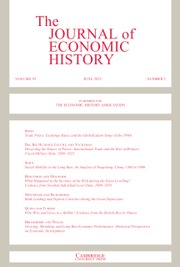The Messina-Reggio Calabria Earthquake of December 1908 was the most destructive earthquake, and one of the most devastating natural disasters, in modern European history. An estimated 90,000–120,000 people—mostly in the municipalities closest to the earthquake’s epicenter, including the region’s urban centers of Messina and Reggio Calabria—were killed by the earthquake itself and by the ensuing tsunami. The earthquake also caused widespread destruction to buildings and infrastructure (Dickie Reference Dickie2008; Dickie and Sayer Reference Dickie and Sayer2005; Parrinello Reference Parrinello2015; Risk Management Solutions 2008).
The historical importance of this earthquake is compounded by the setting in which it struck. It occurred at the peak of the Age of Mass Migration (1840–1914), during which over 50 million Europeans migrated to the New World, enabled by open borders and cheap transatlantic transportation, and drawn by high expected returns (Abramitzky and Boustan 2017; Hatton and Ward Reference Hatton, Ward, Diebolt and Haupert2019; Hatton and Williamson Reference Hatton and Williamson1998). By 1908, Italy had become a leader in this movement, sending hundreds of thousands of migrants each year to the Americas, in what amounted to one of the largest free flows of international migration in history (Foerster Reference Foerster1919; Gomellini and Ó Gráda 2013). The affected regions of Sicily and Calabria had just come to the forefront of this movement, with extremely high rates of emigration by any historical standard and sufficient recent exposure to migration to develop thick networks of prior migrants (Spitzer and Zimran Reference Spitzer and Zimran2024). International migration was thus a familiar, attractive, and relatively easy disaster relief option for the affected population. But was it used as such?
The expected effect of natural disasters on international migration is theoretically ambiguous (e.g., Berlemann and Steinhardt 2017; Black et al. Reference Black, Arnell, Neil Adger, Thomas and Geddes2013; Mahajan and Yang Reference Mahajan and Yang2020). International migration can serve as an adjustment mechanism and provide relief in the face of negative economic shocks (e.g., Mahajan and Yang Reference Mahajan and Yang2020; Ó Gráda Reference Gráda2019; Ó Gráda and O’Rourke 1997). On the other hand, disasters might hinder migration through a variety of mechanisms, including tightened liquidity constraints (Cattaneo and Peri Reference Cattaneo and Peri2016), greater economic opportunities or needs at home (Halliday Reference Halliday2006), and remittances or other financial inflows to affected areas (Yang 2008a). Although each natural disaster is unique, studying them helps to better understand the mechanisms and circumstances that govern their effects. We, therefore, ask, in the context of the Messina-Reggio Calabria Earthquake, whether emigration was a relief valve, and what made communities more likely to react in one way or the other.
Our analysis is based on a dataset of annual emigration rates for every municipality (comune) in Italy for the pre-WWI period, focusing on the period 1905–1912.Footnote 1 It is based on two main sources—passenger manifests of Italians arriving at the Port of New York (Spitzer and Zimran Reference Spitzer and Zimran2018) and official Italian emigration statistics (Spitzer and Zimran Reference Spitzer and Zimran2024)—combined with municipality-level measures of earthquake damage (Guidoboni et al. Reference Guidoboni, Graziano Ferrari, Comastri, Tarabusi and Valensise2007) and an extensive dataset of characteristics of Italian municipalities and districts compiled from censuses and other official historical sources.Footnote 2 We use difference-in-differences and event study specifications to determine whether the emigration trends of severely damaged municipalities in Sicily and Calabria differed from those of other municipalities in those regions following the earthquake.
Our main finding is that there is no evidence of a large positive impact of severe damage caused by the earthquake on emigration from affected municipalities as a whole. Our preferred point estimates, though imprecise, suggest a small and transitory decline in emigration of about 10 percent in the first year after the shock in municipalities experiencing severe damage. We can conclude that the impact of the earthquake was small relative to historical benchmarks. This finding is striking given the extreme toll of the earthquake, the disruption of economic activity that it induced, the large (but short-lived) internal refugee movement that it created, the slow reconstruction that followed it, and the ubiquity of migration prior to the shock.
We test a number of explanations for limited and non-positive migration responses to natural disasters that have been proposed in the literature. The degree of attachment to the land is the most robust factor: we find that municipalities in districts with a greater share of the labor force employed as agricultural day laborers (as opposed to owner-occupiers, renters, sharecroppers, etc.), whose lack of property or contractual obligation to the land would have made them most readily able to quickly decide to emigrate, experienced a greater increase in emigration. This finding is consistent with prior work, which has identified attachment to the land as a factor limiting emigration during the Age of Mass Migration (e.g., Hatton Reference Hatton2010; Hatton and Williamson Reference Hatton and Williamson1998; Wegge Reference Wegge2021) as well as in contemporary migration (e.g., Blanchard et al. Reference Blanchard, Katz, Hall and Eichengreen1992; Valsecchi Reference Valsecchi2014). Ours is the first evidence that it can hinder short-term adjustment in the face of shocks. We test and rule out mechanisms such as greater exigencies (reduced demand for migration due to high returns to reconstruction; Halliday Reference Halliday2006), a positive labor demand shock in the construction sector, and exacerbation of liquidity constraints.
This paper contributes to the literature on the effects of natural and man-made disasters on migration and, thus, to the literature on climate- and disaster-driven migration (Myers Reference Myers2002), as well as to the broader literature on the effects of natural disasters. Interest in understanding the effect of natural disasters on international migration has grown recently, and a number of recent studies have found non-positive effects (e.g., Beine, Noy, and Parsons Reference Beine, Noy and Parsons2019; Beine and Parsons Reference Beine and Parsons2015; Cattaneo and Peri Reference Cattaneo and Peri2016; Gröschl and Steinwachs Reference Gröschl and Steinwachs2017; Halliday Reference Halliday2006; Hunter, Murray, and Riosmena Reference Hunter, Murray and Riosmena2013; Nawrotzki and DeWaard Reference Nawrotzki and DeWaard2018; Shakya, Basnet, and Paudel Reference Shakya, Basnet and Paudel2022). However, this evidence comes almost entirely from events occurring in recent decades, where stringent legal restrictions on international migration potentially add a distorting filter to economic incentives. Evidence from events that occurred in the absence of such barriers has been lacking. Our finding, that a shock as cataclysmic as the Messina-Reggio Calabria earthquake had no meaningfully positive impact on international migration even in a context of widespread and unhindered mass migration, is an important addition to recent evidence demonstrating non-positive effects of natural disasters and other climatic shocks on international migration. Moreover, our exploration of an array of proposed mechanisms and our evidence regarding attachment to the land as an obstacle to adjustment through migration adds to the possible explanations for non-positive responses.
This paper also contributes to the literature on the effects of the Messina-Reggio Calabria Earthquake, which has been the subject of repeated scholarly investigations for more than a century (e.g., Bertolaso et al. Reference Bertolaso, Boschi, Guidoboni and Valensise2008; Dickie Reference Dickie2008; Dickie and Sayer Reference Dickie and Sayer2005; Mercalli Reference Mercalli1909). Debates continue regarding the toll of the earthquake in lives and damage, as well as on the magnitude of internal population movements in its wake (e.g., Caminiti Reference Caminiti2009; Mortara Reference Mortara1913b; Parrinello Reference Parrinello2012; Restifo Reference Restifo1995). This paper adds to our knowledge about the aftermath of this event in three ways (see also Spitzer, Tortorici, and Zimran Reference Spitzer, Tortorici and Zimran2024). First, it supports the view that prior scholarship has overstated the earthquake’s death toll and its impact on internal migration. Second, we study, for the first time, its effects on international migration. Finally, we focus on the experience of small municipalities other than Messina and Reggio Calabria, which have been the subject of earlier research.
BACKGROUND
The Earthquake and Its Aftermath
The 7.1-Richter magnitude Messina-Reggio Calabria Earthquake struck the Strait of Messina and its surroundings on 28 December 1908. It was followed by a severe tsunami (Risk Management Solutions 2008), which ravaged nearby coastal communities. The earthquake is regarded as one of the most destructive natural disasters in modern European history (Dickie Reference Dickie2008). The area’s main cities, Messina and Reggio Calabria, were almost entirely destroyed (Baratta Reference Baratta1910; Mercalli Reference Mercalli1909), and many smaller communities in the regions of Sicily and Calabria were also reduced to rubble (Baratta Reference Baratta1910; Liberti Reference Liberti1993).
In total, the disaster is estimated to have caused 90,000–120,000 deaths, mostly in the two urban centers. In the municipality of Messina alone (i.e., in the city of Messina and in some outlying frazioni within the comune), an estimated 30,000–60,000 inhabitants were killed relative to a 1901 population of just under 150,000 (Caminiti Reference Caminiti2009; Dickie Reference Dickie2008; Guidoboni and Mariotti Reference Guidoboni, Mariotti, Bertolaso, Boschi, Guidoboni and Valensise2008; Parrinello Reference Parrinello2012; Restifo Reference Restifo1995, Reference Restifo, Bertolaso, Boschi, Guidoboni and Valensise2008)—a mortality rate of 20–40 percent. In Reggio Calabria, an estimated 8,000 inhabitants were killed (18 percent). Similarly, Palmi, a smaller Calabrian commercial center near the Tyrrhenian coast (pop. 13,346 in 1901), and Sant’Eufemia d’Aspromonte, a nearby uphill town (pop. 6,285 in 1901), were “dead,” according to the Bishop of Palmi (Liberti Reference Liberti1993). Palmi had an estimated 700 dead and 1,000 injured; out of 2,221 buildings, 445 were completely destroyed, 1,189 irreparably damaged, and 387 more lightly damaged; Sant’Eufemia d’Aspromonte had 839 dead; out of 1,200 buildings, only 100 survived, and even these were badly damaged (Baratta Reference Baratta1910, pp. 198–207).
Such high mortality rates were atypical even among severely damaged municipalities. Of 110 municipalities that we define as severely damaged, only 11 had mortality rates of 5 percent or greater. Most severely damaged municipalities experienced the earthquake primarily as a shock to infrastructure. Figures for Sicily are lacking, but detailed data on damage are available for all municipalities in the province of Reggio Calabria. In the average municipality (excluding Reggio Calabria itself), about 23 percent of buildings were completely destroyed and another 24 percent were heavily damaged (Baratta Reference Baratta1910, pp. 198–207; see Online Appendix Figure B.1 for a map of districts in the affected area). The damage in some municipalities was so severe that the renowned seismologist Giuseppe Mercalli added a new intensity degree to his eponymous scale to describe it—XI, catastrofe (Tertulliani Reference Tertulliani2014).
Immediately following the earthquake, at least 66,000 refugees are estimated to have left Messina. However, there are indications that this flow was short-lived, such that “immediately following the exodus from the scene of the disaster, a counter-exodus began” (Restifo Reference Restifo1995, p. 562). The population of the cities of Messina and Reggio Calabria rebounded quickly, as shown in Table 1 (see also Mortara Reference Mortara1913a, 1913b; Parrinello Reference Parrinello2012; Restifo Reference Restifo1995). According to the traditional view of the Messinesi, this demographic recovery was largely due to an inflow of newcomers from the hinterland (Dickie and Sayer Reference Dickie and Sayer2005). Such an inflow, if true, is important for our case, as it potentially would have captured individuals who would otherwise have emigrated in response to the shock. However, a more detailed examination of Italian census figures from 1901 and 1911, along with data on emigration, return migration, births, and deaths, reveals that the local myth of population replacement cannot be correct, and that the inflow of newcomers to the cities of Messina and Reggio Calabria was likely small.
Table 1 POPULATION OF THE CITIES OF MESSINA AND REGGIO CALABRIA BY BIRTHPLACE, 1901 AND 1911
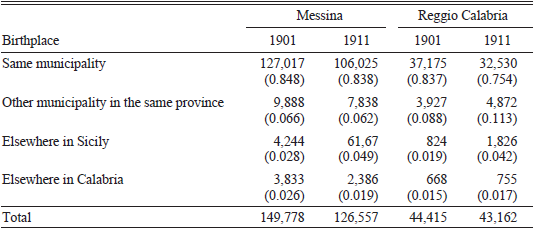
Notes: The “Total” row includes births elsewhere in Italy and abroad; for this reason, the first four rows of each column do not sum to the figure in the “Total” row. Fractions of total population in parentheses.
Sources: The 1901 Italian census of population, Volume II, Table V.A, pages 357–58 and the 1911 Italian census of population, Volume VI, Table IX.A, pages 78 and 85.
Table 1 presents data on the population of the cities of Messina and Reggio Calabria by place of birth from 1901 and 1911 population censuses (similar data are not available for smaller towns). Two years after the disaster, 83.8 percent of Messina’s 126,557 residents were listed as natives of the city, whereas only 6.2 percent were born elsewhere in the province of Messina, even less than their share in 1901.Footnote 3 Thus, in 1911 the number of non-native residents in these cities was too small to be consistent with any large inflow of internal migrants in the wake of the earthquake. To provide more concrete bounds on the inflow of newcomers attributable to the earthquake, the Appendix combines these census figures with annual data on births, deaths, and emigrants from 1901–1911 for the municipalities of Messina and Reggio Calabria, along with information on return migration to their respective provinces.
First, as a by-product of these calculations, we compute alternative upper bounds to the death tolls from the earthquake for the two cities—35,193 in Messina and 9,298 in Reggio Calabria. The upper bound for Messina is well short of the official but long-suspected statistic of over 60,000 fatalities, increasing our skepticism of the official count and lending more credibility to the lower range of estimates. For Reggio Calabria, however, the upper bound somewhat exceeds the official estimate of 8,000, suggesting that the official toll is plausible. This is consistent with most uncertainty arising from questions over Messina’s death toll.
Our upper bound for the net internal migration to these major cities over the entire period 1901–1911 is 10,581 for Messina and 7,623 for Reggio Calabria. These estimates pale in comparison to international emigration flows, which averaged over 15,600 per year from the province of Messina over the period 1905–1908 (of which over 13,000 per year were from municipalities other than Messina) and over 14,300 emigrants per year from the province of Reggio Calabria over the same period. Moreover, as we argue in the Appendix, these upper bounds likely overstate the internal migration that occurred as an actual response to the earthquake. Thus, local folk history notwithstanding, internal migration to the two major cities was not sufficiently large to reroute significant flows that would have constituted a positive international migration response if directed abroad.
Whether the affected population responded to the disaster through international migration remains an open question with important implications for a complete understanding of this event, for the economics of the Age of Mass Migration, and for the economics of disaster-induced migration. Importantly, there is no evidence that the earthquake hindered migration by disrupting travel: Messina’s importance as a point of embarkation for transatlantic migration was negligible relative to that of Palermo, Naples, and Genoa (Spitzer, Tortorici, and Zimran Reference Spitzer, Tortorici and Zimran2024).
The Economy of the Strait of Messina after the Earthquake
The earthquake ravaged the local economy. Widespread destruction of residential structures amounted to a massive loss of household wealth as well as a deterioration in living standards. Recovery and reconstruction were extremely slow, with little progress made even by the 1930s (Farinella and Saitta Reference Farinella and Saitta2019; Teti Reference Teti, Bertolaso, Boschi, Guidoboni and Valensise2008).
The local economy was largely based on agriculture, primarily grains, while the export and the subsidiary industry of tree crops such as olives, vines, and citrus had become increasingly important by the time of the earthquake. This trade was disrupted by the damage to the port of Messina, which had been its main outlet. Mortara (Reference Mortara1913a, 1913b) documented a severe economic downturn that lasted about two years before partial recovery began in 1911. For example, the value of trade passing through Messina in 1909 was less than half its 1907 value, with a more pronounced decline (70 percent) in exports than in imports; even in 1911, the value of exports was still one-third below the 1901–1907 average (Mortara Reference Mortara1913b, p. 269). Some of this decline was offset by trade diversion to nearby regions, however, with citrus exports from Catania increasing by 51 percent from 1907 to 1909 and continuing to rise thereafter. Indicators of banking activity were generally reduced by more than 50 percent, with profits of credit institutions slashed by an order of magnitude (Mortara Reference Mortara1913b, pp. 283–284). The agricultural processing sector was also badly damaged. A similar impression is provided by the report of the committee charged with overseeing the distribution of funds in the area, which cited substantial damage to local industry that in turn necessitated aid and loans for reconstruction.Footnote 4
Trends in taxable income provide insight regarding trends in overall income and economic activity (Mortara Reference Mortara1913b, pp. 260, 298). Taxable capital income fell by two-thirds in 1909 and 1910 and taxable mixed labor-capital income fell by four-fifths. Even as late as 1912, revenues in both categories remained well below their 1908 levels. Highly paid labor income also fell by two-thirds in the first two years after the earthquake, but recovered to above its previous level by 1912, as did public workers’ income, the decline of which was more moderate, though still substantial (40 percent in 1909 and 26 percent in 1910). These measures suggest that communities most affected by the earthquake suffered an economic downturn comparable to events such as the Great Depression or the Dust Bowl and that these impacts were felt for several years before recovery began. It is likely that the shock to commercial hubs, such as the city of Messina, had wider economic implications in the region—an issue that we tackle later.
Natural Disasters and Migration: Theory and Evidence
The Messina-Reggio Calabria Earthquake is an exemplary case of a large-scale, sudden, and localized natural disaster, comparable to floods, hurricanes, volcanic eruptions, and, of course, other earthquakes. Such events are distinct from, although not unrelated to, other types of natural and manmade disasters such as prolonged drought, crop destruction, famine, war, or societal or state collapse. Much of the current literature studying them is motivated by the goal of understanding the effects of climate change on population movements in developing countries in recent decades (Berlemann and Steinhardt 2017; Black et al. Reference Black, Arnell, Neil Adger, Thomas and Geddes2013). The simplest mechanism by which natural disasters can impact migration is by augmenting push factors (Baez and Santos Reference Baez and Santos2008; Banerjee Reference Banerjee2007; Cai et al. Reference Cai, Feng, Oppenheimer and Pytlikova2016; Gröger and Zylberberg Reference Gröger and Zylberberg2016), not least due to the destruction of residential capital. Indeed, there is ample evidence that they can cause short-term and short-distance internal migration (e.g., Gray and Mueller Reference Gray and Mueller2012; Gröger and Zylberberg Reference Gröger and Zylberberg2016; Penning-Rowsell, Sultana, and Thompson Reference Penning-Rowsell, Sultana and Thompson2013; Robalino, Jimenez, and Chacón Reference Robalino, Jimenez and Chacón2015), permanent long-distance internal migration (Boustan, Kahn, and Rhode Reference Boustan, Kahn and Rhode2012; Hornbeck Reference Hornbeck2012; Hornbeck and Naidu Reference Hornbeck and Naidu2014; Sichko 2021), or even international migration (e.g., Drabo and Mbaye 2014; Murathanoğlu Reference Murathanoğlu2023; Reuveny and Moore Reference Reuveny and Moore2009). The most comprehensive evidence for such a positive effect comes from Mahajan and Yang’s (2020) study of the effect of hurricanes on migration to the United States (1980–2000).
However, a number of studies have found negative or no-migration effects, at least for large segments of the population (e.g., Beine and Parsons Reference Beine and Parsons2015; Cattaneo and Peri Reference Cattaneo and Peri2016; Gröschl and Steinwachs Reference Gröschl and Steinwachs2017; Halliday Reference Halliday2006; Hunter, Murray, and Riosmena Reference Hunter, Murray and Riosmena2013; Yang 2008b). This is a common finding even for internal migration (Cattaneo and Peri Reference Cattaneo and Peri2016; Gignoux and Menéndez Reference Gignoux and Menéndez2016; Nawrotzki and DeWaard Reference Nawrotzki and DeWaard2018; Paul Reference Paul2005; Penning-Rowsell, Sultana, and Thompson Reference Penning-Rowsell, Sultana and Thompson2013), and it gives rise to the notions of trapped populations (Nawrotzki and DeWaard Reference Nawrotzki and DeWaard2018) and an immobility paradox (Beine, Noy, and Parsons Reference Beine, Noy and Parsons2019). Findings of heterogeneous effects of shocks on migration with respect to income, wealth, or human capital, and specifically a lesser increase in migration after a shock among worse-off households, regions, or countries (Beine and Parsons Reference Beine and Parsons2017; Cattaneo and Peri Reference Cattaneo and Peri2016; Gröschl and Steinwachs Reference Gröschl and Steinwachs2017; Nawrotzki and DeWaard Reference Nawrotzki and DeWaard2018; Sichko Reference Sichko2024; c.f., Halliday Reference Halliday2006; Sichko, Zimran, and Howlader Reference Sichko, Zimran and Howlader2025), are consistent with this phenomenon. Another mechanism that could offset positive push effects is that reconstruction may increase local demand for labor, either within the household or in the labor market. Such greater exigencies at home have been cited by Halliday (Reference Halliday2006) as the most likely explanation for the negative effect of the 2001 El Salvador earthquakes on migration to the United States (c.f., Yang 2008b). Moreover, reconstruction efforts are often fueled by remittances and other forms of financial flows to the affected places (Bettin and Zazzaro Reference Bettin and Zazzaro2018; David Reference David2011; Mohapatra, Joseph, and Ratha Reference Mohapatra, Joseph and Ratha2009; Murathanoğlu Reference Murathanoğlu2023; Paul Reference Paul2005; Sichko, Zimran, and Howlader 2025; Yang 2008a; c.f., Lueth and Ruiz-Arranz Reference Lueth and Ruiz-Arranz2008).
Italian Emigration
By the 1890s, Italy had become one of the main sources of international migrants (Ferenczi and Willcox Reference Ferenczi and Willcox1929; Foerster Reference Foerster1919; Gomellini and Ó Gráda 2013; Hatton and Williamson Reference Hatton and Williamson1998, p. 97; Spitzer and Zimran Reference Spitzer and Zimran2024). For Sicily and Calabria, the main destination was North America (primarily the United States), to which the rate of migration regularly exceeded 20 per thousand after 1900. Between 1901 and 1914, 71 percent of migrants from these regions traveled to North America and 22 percent to South America. Most migrants were young, male, and unskilled or semi-skilled manual workers (Pérez Reference Pérez2021; Spitzer and Zimran Reference Spitzer and Zimran2018). According to official Italian emigration statistics, in 1905–1908, 49.9 percent of Calabrian migrants and 38.1 percent of Sicilian migrants were agricultural workers (Statistica della Emigrazione Italiana per l’Estero).
As was typical for the period, Italian migration was characterized by considerable volatility in response to business cycles in the destination countries, such as the recession that followed the Panic of 1907 (Hatton and Williamson Reference Hatton and Williamson1998, ch.4; Spitzer Reference Spitzer2015). Importantly, Italian migration evolved in a process of spatial diffusion, expanding outward from a few epicenters (Spitzer and Zimran Reference Spitzer and Zimran2024). The relevant epicenter districts for Sicily and Calabria were Corleone, in the province of Palermo, to the west, and Sala Consilina, in the province of Salerno, to the north. In the years before the earthquake (1905–1908), municipalities within a radius of 150 kilometers from the earthquake’s epicenter experienced an average annual emigration rate of over 35 per thousand—extraordinarily high by any standard. We interpret this as having passed a point of saturation—a previous migrant stock large enough that it was likely that virtually all residents had a connection to earlier migrants who could aid them in migration. However, the provinces of Catania and Siracusa in southeastern Sicily, farther from the emigration epicenters, trailed the rest of Sicily and Calabria, and achieved saturation only in the early 1910s. This meant that emigration from this area was on a rising trend relative to the area around the Strait of Messina in the period that we analyze. This external reason for differential trends in across parts of the regions affected by the earthquake is an important factor to consider in our analysis.
Internal migration within Italy might have been an important margin of response to the earthquake, potentially constituting a substitute for international migration. Although data sources on internal migration are very limited, we know that, at least in southern Italy in our study period, it was far less common than international migration (Gallo Reference Gallo2012). As discussed previously, the cities of Messina and Reggio Calabria did not attract a large number of rural migrants after the earthquake, leaving overseas migration as the primary outside option. Delaying return migration might also have provided households with a margin on which to adjust to the earthquake. Due to the paucity of the available data on return migration, we cannot reliably estimate the magnitude of its response to the earthquake; in Online Appendix C, we present evidence suggesting that it might have been substantial.
DATA
Spitzer, Zimran, and Tortorici (2025) provide data and code to replicate the results presented in this paper.Footnote 5
Sources and Construction
Data on earthquake severity (Guidoboni et al. Reference Guidoboni, Graziano Ferrari, Comastri, Tarabusi and Valensise2007) are largely based on descriptions of earthquake damage by Baratta (Reference Baratta1910), and include death counts and Mercalli severity scores for various locations.Footnote 6 Whereas the commonly referenced Richter scale is based on energy released by the earthquake, which may translate into damage differently in different areas, the Mercalli scale is based on damage. It ranges from I (not felt) to XII (extreme; other definitions in Online Appendix Table B.1). We assigned the severity measures to the municipalities into which they fall.Footnote 7 For municipalities with no severity measures, we used an inverse-distance-weighted imputation of Mercalli scores. Our benchmark treatment variable is a binary indicator for severe damage, using VIII as a cutoff.Footnote 8 This severity level entails substantial damage to ordinary buildings, whereas VII implies considerable damage only to poorly built structures. We explore the robustness of the results to the severity cutoff and to different measures of treatment.
We use two sources of migration data. The first is the Ellis Island arrival records database, which was provided by the Statue of Liberty-Ellis Island Foundation (Spitzer and Zimran Reference Spitzer and Zimran2018). This dataset contains the records of all passenger arrivals at the Port of New York for the period 1897–1924, comprising the vast majority of entries during this time. These records appear highly accurate, likely due to the requirement to travel abroad with a passport (Foerster Reference Foerster1919, pp. 10–22), which identified migrants’ municipalities of origin. We use Spitzer and Zimran’s (2018) geolocation algorithm, which has been shown to yield an accurate and representative sample of all passengers. In total, we assigned a municipality of origin to 1,445,096 passengers arriving 1905–1912.Footnote 9 The transcribed passenger lists also contain a limited number of individual characteristics, including age and gender.
Our second and complementary source of migration data is the official municipality-level annual emigration counts published in the Statistica della Emigrazione Italiana per l’Estero (Spitzer and Zimran Reference Spitzer and Zimran2024), based on passport issuances. Although these data add information relative to the Ellis Island records by covering all destinations (rather than just the United States) and ports of entry (rather than just New York), they lack information on migrants’ demographics. Moreover, records for the districts of Palmi and Messina for the fourth quarter of 1908 were destroyed by the earthquake and were imputed based on 1907 figures. The earthquake may also have disrupted travel plans, leading to a discrepancy between passport issuances and actual emigration. Therefore, we use the Ellis Island data for our benchmark specification, while reporting alternative results using the official emigration data for robustness.
Finally, we collected data on the characteristics of Italian municipalities and districts from a variety of official sources. The 1901 Italian census of population, the last before the earthquake, provides municipality-level population counts and district-level occupational distributions (1901 Census, Volume III, Table C). We are particularly interested in the distribution of the different types of contractual attachment to land for agricultural workers, which was likely the most important factor differentiating the status of the rural working class, who formed the majority of the population and of those who migrated. The least attached were the agricultural day laborers (giornalieri di campagna). Other categories indicate a more rigid attachment—sharecroppers (mezzadri), contracted laborers (contadini obbligati), renters, lessees, and owner-occupiers. Important as well for our case is employment in construction and in credit and banking. We also use district-level information on the rates of ownership of real estate in the form of land and buildings (1901 Census, Volume IV, Table VIII.B), as well as literacy rates and the fraction of the population under age 15 (1901 Census, Volume II, Table III.B).
To evaluate the role of liquidity constraints in muting a potential earthquake response, we collected and digitized municipality-level information on various tiers of the Italian financial system. First, we have data on the assets of and the short- and long-duration loans provided by banks of various levels (Natoli et al. Reference Natoli, Piselli, Triglia and Vercelli2016), including data on the upper and middle tiers of the banking system—ordinary credit or joint-stock banks (Società Ordinarie di Credito), cooperative banks (Banche Popolari), and savings banks (Casse di Risparmio Ordinarie).Footnote 10 These institutions were typically located in district capitals and sometimes hard to access by the southern peasantry; moreover, the data are informative of their main locations, potentially to the exclusion of branches. Lower-tier institutions were prevalent in many small localities, and the degree of their development was likely a good indicator of access to credit, savings, and mutual assistance. Natoli et al. (Reference Natoli, Piselli, Triglia and Vercelli2016) provide data on one such institution—pledge banks (Monti di Pietà). These pawn shops, which operated as charitable religious institutions, were widely diffused, particularly in less developed areas such as Sicily and Calabria, and handled much of the country’s small-scale credit (Carboni and Fornasari Reference Carboni and Fornasari2019; Pascali Reference Pascali2016). The most recent year with complete coverage prior to the earthquake is 1905, and we use the data to compute each municipality’s log assets per capita and log credit per capita, as well as analogs of these measures within a 25-kilometer radius of each municipality. Access to household funds is measured using data on postal savings banks (Casse Postali di Risparmio), which were perhaps the most important repository for the savings of the working classes (Relazione intorno al servizio delle Casse Postali di Risparmio durante l’anno 1887). Their branches were ubiquitous in small-sized localities, and they are informative of localized access to savings that could have funded emigration. We collected data on these banks, of which the most recent available source prior to the earthquake was in 1887. Again, we use this source to produce local and 25-kilometer radius per capita measures. Another important institution was Mutual Aid Societies (Società di Mutuo Soccorso), for which we collected data on membership and endowment in each municipality in 1904 (Le Società di Mutuo Soccorso in Italia al 31 Dicembre 1904). Such societies may have been helpful in raising funds under stress, and, more broadly, their presence constitutes an indicator for high social capital that could be used for the same end.Footnote 11
Summary Statistics
Table 2 presents summary statistics for earthquake exposure and emigration for severely damaged and other municipalities. Severely damaged municipalities were closer to the earthquake epicenter and had a higher fatality rate. Figure 1 maps the data on damage from the earthquake. Panel (a) presents the Mercalli score for each municipality (excluding those without data in Guidoboni et al. Reference Guidoboni, Graziano Ferrari, Comastri, Tarabusi and Valensise2007), while Panel (b) maps the severely damaged. Severity is clearly a decreasing function of distance from the earthquake’s epicenter (indicated by the large dot), but there is still considerable local variation.
Table 2 SUMMARY STATISTICS FOR EARTHQUAKE EXPOSURE AND EMIGRATION

Notes: Standard deviations in parentheses. Observations are at the municipality-year level. Mercalli measures are imputed where missing. Observation numbers are the minimum with observations for migration, distance from earthquake epicenter, deaths, and population in the Ellis Island dataset. Municipality numbers are the number of distinct municipalities among these observations. Prime-aged defined as ages 18–65.
Columns (1), (3), and (5) indicate whether the differences between the severe and non-severe groups are statistically significant based on the district-clustered bootstrap. Notation is ap<0.01, bp<0.05, cp<0.1.
Source: See text.
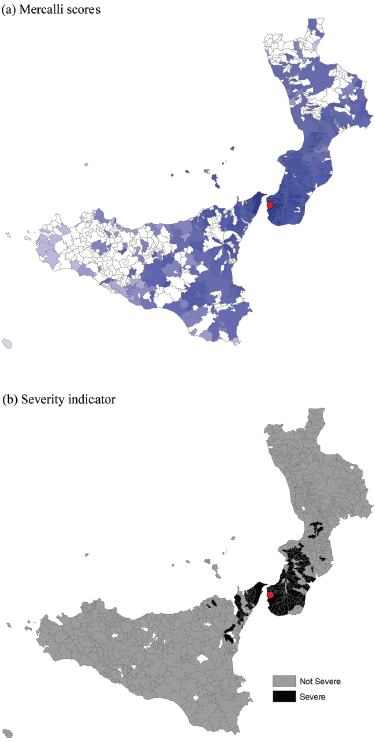
Figure 1 EARTHQUAKE DAMAGE
Notes: The large dot indicates the earthquake epicenter. Panel (a) presents Mercalli scores. Darker colors indicate higher severity; white municipalities have no data. Panel (b) presents the severity indicator with a Mercalli cutoff of VIII. White municipalities in Panel (b) were created in the 1920s or later.
Source: See text.
Emigration rates according to the Ellis Island data are approximately half those reported in the official emigration data, as they only include Ellis Island arrivals with identified places of origin. Figure 2 presents the spatial distribution of our main outcome variable—average annual emigration rates at the municipality level according to the Ellis Island data.Footnote 12 Panel (a) reports emigration during the pre-earthquake period 1905–1908 and shows lower emigration rates from southeastern Sicily. Panel (b) reports the change in emigration after the earthquake (the ratio of the rates for 1909–1912 to those for 1905–1908). Consistent with the expansion of migration to the southeast of Sicily, the greatest increase was in this area; otherwise, there is no clear relationship between proximity to the earthquake epicenter and the change in emigration rates.
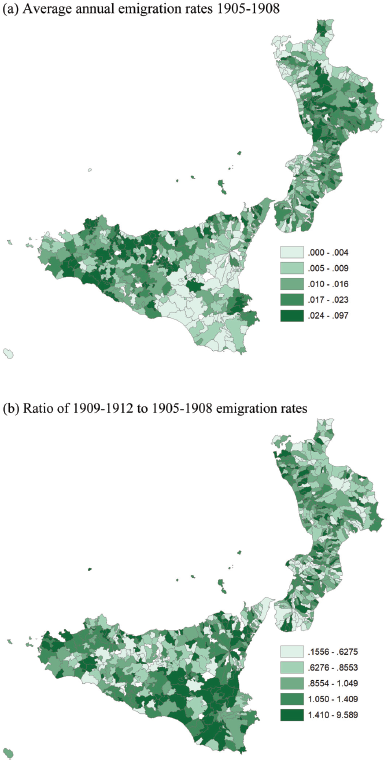
Figure 2 MUNICIPALITY-LEVEL EMIGRATION RATES
Notes: Data are from Ellis Island. Panel (a) shows average annual emigration rates for 1905–1908. Panel (b) shows the ratio of the average annual emigration rate for 1909–1912 to that for 1905–1908. Both scales are based on quantiles of the distribution.
Source: See text.
Table 3 presents summary statistics for characteristics of municipalities and districts and includes tests for statistical significance of differences between severely damaged and other municipalities.Footnote 13 Severely damaged municipalities were, on average, farther from emigration epicenters than were other municipalities, and were in districts with a greater share of employment in construction and with fewer property owners per capita. Municipalities of both groups were in districts with, on average, similar levels of employment in credit and agricultural day labor. Severely damaged municipalities were also in districts with somewhat lower property ownership. There are some substantial differences in measures of financial development and social capital, but the signs of the differences vary, and no group clearly dominates the other.
Table 3 SUMMARY STATISTICS FOR MUNICIPALITY AND DISTRICT CHARACTERISTICS
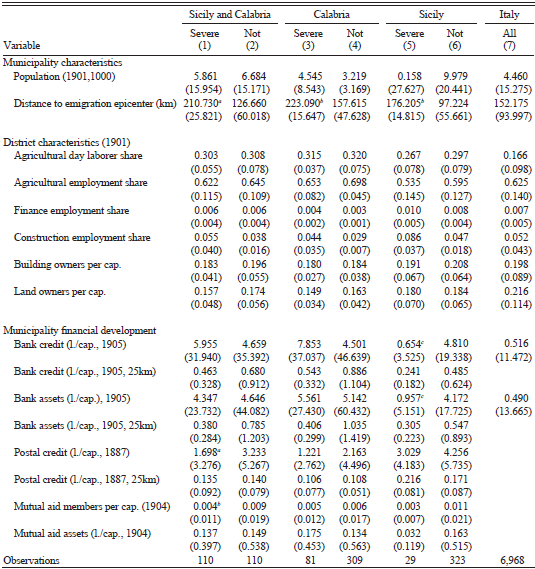
Notes: Standard deviations in parentheses. Observations are at the municipality level. Observation numbers are the minimum with observations for all variables in the Ellis Island dataset. The abbreviation l./cap. in the municipality financial development measures denotes lire per capita.
Significance levels, district-clustered b.s.: Columns (1), (3), and (5) indicate whether the differences between the severe and non-severe groups are statistically significant based on the district-clustered bootstrap. Notation is ap<0.01, bp<0.05, cp<0.1.
Source: See text.
The first indications of our main finding appear in Table 2: emigration rates in both severely and non-severely damaged municipalities declined somewhat over time, but did so slightly more in the first group. In Panel (b) of Figure 2, there is little apparent impact of the earthquake. Finally, Figure 3 plots the ratio of the post-to-pre (i.e., 1909–1912 to 1905–1908) emigration rates against the 1905–1908 average annual emigration rates, separately for each group. It appears that any impact of the earthquake was of secondary importance as compared to the patterns of convergence in emigration rates discussed earlier: there is a clear downward slope in the plots (β-convergence), but there is little difference between the trends of the two groups.
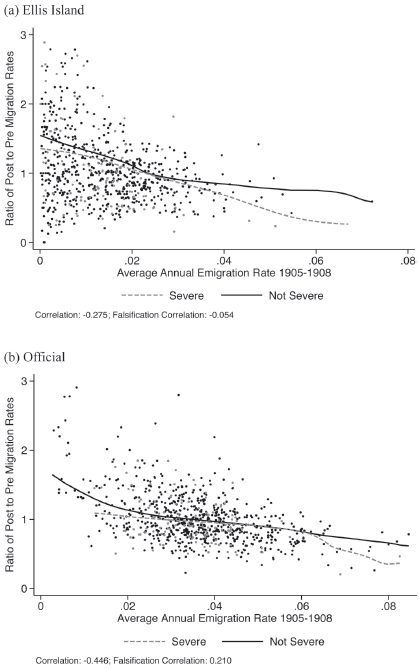
Figure 3 β-CONVERGENCE IN EMIGRATION RATES
Notes: “Severe” indicates municipalities experiencing severe damage from the earthquake. “Not Severe” indicates all other municipalities in Sicily and Calabria. This figure plots the ratio of 1909–1912 emigration rates to 1905–1908 rates against the average rate for 1905–1908. Some municipalities are omitted from the scatterplots (but not the regressions) for clarity. To address concern regarding spurious correlation, we follow Spitzer (Reference Spitzer2021) and Spitzer and Zimran (Reference Spitzer and Zimran2024) in also reporting the correlation between the ratio and the post-earthquake emigration rate. That there is such a positive correlation that is smaller in magnitude than the negative correlation between the ratio and the pre-earthquake emigration rates is evidence that some but not all of the relationship is spurious.
Source: See text.
EMPIRICAL STRATEGY
Our empirical strategy is a generalized difference-in-differences at the municipality level, focusing on an eight-year window surrounding the earthquake (1905–1908 and 1909–1912). The benchmark sample is limited to the regions of Sicily and Reggio Calabria, where all affected municipalities are located. The estimation equation is
where α pt are province-year fixed effects, α i are municipality fixed effects, and e it is emigration rate of municipality i in year t. We examine alternative outcome variables as well, representing different aspects of emigration, including an Ellis Island-based measure of migration of prime-aged (18–65) males, whom we consider the group that was the most likely to react to labor market incentives, emigration rates according to Italian official statistics, and earthquake fatality-adjusted emigration rates. The province-year fixed effects capture province-specific year-to-year variations and, at least in part, the regional economic fallout of the earthquake. The coefficient of interest is β, which estimates the interaction between severe damage (s i) and the post-period 1909–1912 (q t); it can be interpreted as the additional effect of experiencing severe damage on top of the province-level fallout.Footnote 14 Equation (1) also includes an interaction between the distance from the nearest emigration epicenter (d i) and the post indicator to account for differential trends stemming from distance to the early sources of emigration. We also adapt Equation (1) into an event study specification of the form
where all terms are defined analogously to Equation (1), and the coefficients β and γ vary by year.
We take several approaches to inference. The treatment varies at the level of the municipality, and it might be natural to cluster standard errors at this level; but this would rule out cross-municipality correlation, which we find implausible, leading us to use Conley (Reference Conley1999) standard errors. In later analyses, however, we will use variables that vary only at the district level. Thus, our preferred approach is to cluster at the higher level of the district, which also permits correlation between municipalities in the same district over different years. Since there are only 35 districts in the regions of Sicily and Calabria, we use Roodman et al.’s (Reference Roodman, Ørregaard Nielsen, MacKinnon and Webb2019) wild bootstrap approach.Footnote 15 Clustering at a higher level, which generally yields wider confidence intervals, works against our argument that there was no large positive effect: while wider confidence intervals eliminate the statistical significance of a wider range of positive effects, they also raise the upper bounds of our confidence intervals.
The nature of earthquakes is such that the treatment is geographically clustered, suggesting a randomization inference method that explicitly incorporates the geographic structure of the shock. Complete details of this method are in Online Appendix F. In brief, we simulate 500 randomly placed earthquakes in Sicily and Calabria, using the distance-damage relationship estimated from the Messina-Reggio Calabria Earthquake. We then re-estimate our regressions for each of the simulated events and compare the true earthquake coefficient to those of the random earthquakes. This exercise produces what we call a tail-mass value, which is the share of estimates in the randomization inference that are more extreme than the true estimate relative to the median of these estimates,Footnote 16 and is a close analog to the ordinary one-sided p-value.
We weight each municipality equally, such that each one constitutes a separate instance. This implies that the cities of Messina and Reggio Calabria are treated as just two of many cases.Footnote 17 Our equal-weighting approach corresponds to the motivation to understand how a typical municipality was affected by the earthquake.
RESULTS
Aggregate Effects of the Earthquake
Our benchmark results point toward the conclusion that there was no large positive impact of the earthquake on subsequent emigration flows. Moreover, although imprecise, our estimates suggest that any effect was negative. Table 4 presents the results of estimating the difference-in-differences specification of Equation (1) for a variety of geographic scopes and definitions of the outcome.Footnote 18 Our preferred estimates, based on the Ellis Island data without adjustments and focusing on Sicily and Calabria as the study regions, are in Column (1) of Panel A. The estimated coefficient of –0.071 indicates a small relative decline in emigration from severely affected municipalities of about 7 percent (6 percent of a standard deviation), and is both statistically insignificant according to the district-clustered wild bootstrap (p > 0.50) and does not stand out according to the randomization inference exercise, with more than one-quarter of the placebo estimates being more negative than our estimate. The remaining specifications in Table 4 show that this qualitative result is not driven by the source of the emigration data, by the inclusion or exclusion of earthquake deaths in computing emigration rates, or by the geographic scope; the estimated effect in all specifications ranges from a decline of 15 log points to a zero impact, and no estimate is statistically significant.Footnote 19
Table 4 DIFFERENCE-IN-DIFFERENCES RESULTS
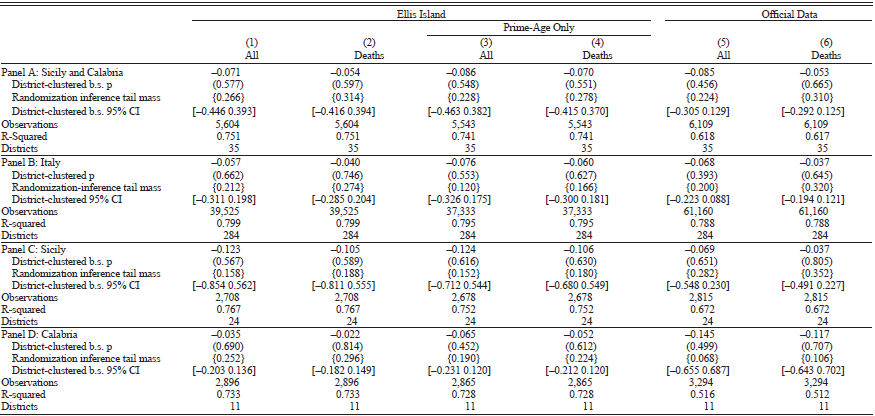
Significance levels, district-clustered b.s.: ap<0.01, bp<0.05, cp<0.1
Notes: This table presents difference-in-differences coefficients β for severe-times-post from estimation of Equation (1). The dependent variable is the logarithm of emigration rates. P-values from a wild bootstrap clustering at the district level are in parentheses. Tail mass values from a randomization inference test are in curly braces. Ninety-five percent confidence intervals from the wild bootstrap clustered at the district level are in square braces. In Panel B, the district-clustered p-values and confidence intervals are based on large-sample approximations. Columns (1), (3), and (5) use unadjusted base populations to compute migration rates; Columns (2), (4), and (6) use populations adjusted for earthquake deaths. All regressions include municipality fixed effects, province-year indicators, and distance from the nearest emigration epicenter-times-post. Observations limited to 1905–1912.
Source: See text.
Figure 4 presents results from the event study specification of Equation (2).Footnote 20 As in Panel A of Table 4, the sample includes all municipalities in Sicily and Calabria. The point estimates show no evidence of a meaningfully different trend for severely damaged municipalities prior to the earthquake. In the first year after the shock, there was a slight (just under 10 log points in Panel A) and statistically insignificant relative decline. This decline diminished by the second year after the earthquake, remaining small and statistically insignificant thereafter, suggesting that any effect was short-lived. There is no resurgence in emigration after the initial decline that would suggest that many individuals had simply delayed migration.
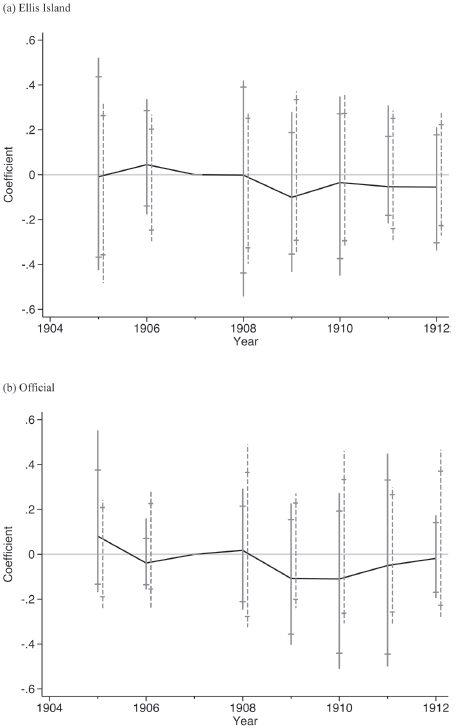
Figure 4 EVENT STUDIES FOR THE EFFECT OF THE EARTHQUAKE ON MIGRATION
Notes: Sample includes all municipalities in the regions of Sicily and Calabria. These are event study coefficients β t from estimating Equation (2). The dependent variable is the logarithm of the emigration rate. Solid bars are 90- and 95-percent confidence intervals from a wild bootstrap clustered on the district level. Dashed bars are the middle 90 and 95 percent of randomization inference replications.
Source: See text.
We repeat the analyses of Table 4 using either the Mercalli score (Online Appendix Table B.5) or the negative distance (in hundreds of kilometers) from the earthquake epicenter (Online Appendix Table B.6) instead of the severe-damage indicator.Footnote 21 Although the coefficients are occasionally statistically significant, the interpretations of the point estimates are similar to those of Table 4. Online Appendix Figure B.4 explores the consequences of changing the definition of severe damage to various Mercalli score cutoffs. Given the small number of municipalities (25) with a severity of IX or greater and our understanding that a Mercalli score of VI or less indicates only negligible damage, the natural alternative cutoff to VIII is VII. As we show in Online Appendix G, in no case does changing the definition of severe damage from VIII to VII materially affect our results. Although, in some cases, the earthquake effect for a cutoff of VII, which is always negative, is marginally significant, the magnitude of the point estimate is not appreciably different, and the tighter confidence intervals strengthen the case for no large positive effect. Nonetheless, since it is our view that VIII is the most appropriate cutoff, we continue to use it throughout the analysis.
Statistical Power and Economic Significance
A challenge to our interpretation of these results as indicating a lack of a large positive effect of the earthquake on migration is that our estimates are statistically imprecise. In the benchmark specification (Table 4, Panel A, Column 1), the 95-percent confidence interval for the earthquake effect ranges from a decrease in emigration of 45 log points to an increase of 39 log points.Footnote 22 This raises the question of whether we can rule out an economically significant positive effect. In part, this imprecision is a product of our conservative approach to inference. Under more liberal approaches, the upper bounds of the 95-percent confidence intervals, when clustering by municipality or using Conley (Reference Conley1999) standard errors, are increases of 9 and 20 log points (Online Appendix Table B.3).
The conclusion also depends on the yardstick for economic significance. Recent studies and historical events offer reasonable yardsticks to gauge economic significance. The closest temporally and spatially is the decline in emigration following the Panic of 1907, just one year before the earthquake. This recession reduced U.S. immigration from all European origin countries (Hatton and Williamson Reference Hatton and Williamson1998, ch. 4). The average severely damaged municipality reduced its emigration rate from 1907 to 1908 from 15 per thousand to 4 per thousand (129.3 log points). This is far outside our most conservative confidence intervals,Footnote 23 meaning that any effect of the earthquake is likely much smaller, in absolute size, relative to this benchmark effect of a large but not unheard-of temporary downturn in the U.S. business cycle. Another useful yardstick is provided by Mahajan and Yang’s (2020) study of the effects of hurricanes on migration to the United States. Applying their estimates (Tables 3 and 5) to a rough estimate of the size of the Calabrian and Sicilian population already present in the United States at the end of 1908, the implied effect of what Mahajan and Yang (Reference Mahajan and Yang2020) call a “one standard deviation” hurricane—a far smaller shock than the Messina-Reggio Calabria earthquake—ranges from 43.9 percent to 106 percent increase in annual migration, again outside our confidence intervals.Footnote 24
Table 5 HETEROGENEOUS RESPONSES WITH RESPECT TO AGRICULTURAL DAY LABOR

Significance levels, district-clustered b.s.: ap<0.01, bp<0.05, cp<0.1
Notes: This table presents results from estimation of Equation (3) for the coefficients β and π. Sample includes all municipalities in the regions of Sicily and Calabria. Dependent variable is the logarithm of the unadjusted emigration rate from the source listed in the column header. P-values from a wild bootstrap clustering at the district level are in parentheses. Tail mass values from a randomization inference test are in curly braces. Ninety-five percent confidence intervals from the wild bootstrap clustered at the district level are in square braces. Ag Share is the fraction of the 1901 male labor force in agriculture at the district level, and is standardized to have mean zero and standard deviation one. Ag Lab Share is the share of the 1901 male labor force in agricultural day labor at the district level, standardized to have mean zero and standard deviation one. All regressions include municipality fixed effects, province-year indicators, and distance from the nearest emigration epicenter-times-post. Observations limited to 1905–1912.
Source: See text.
Labor Force Composition and Heterogeneous Responses to the Earthquake
What could explain the absence of a large aggregate positive impact of the earthquake? We approach this question by looking for local characteristics that were associated with heterogeneous responses to severe earthquake damage. Such responses may have been meaningful in magnitude and duration, even if they canceled each other out in the aggregate. Guided by the competing hypotheses in the literature and by features of the southern Italian economy, we focus on what we consider to be the most likely factors that would limit a positive emigration response to the earthquake—attachment to the land, liquidity constraints, greater exigencies, and demand for reconstruction labor.
We first study the role of the composition of the agricultural working class, which comprised the majority of both the labor force and of the migrants themselves.Footnote 25 Peasants in different categories of agricultural labor differed in their standards of living and in their tenancy status, and moving up the tenancy ladder by leasing or purchasing land was a primary goal of Italian migrants and their households (MacDonald and MacDonald Reference MacDonald and MacDonald1964, p. 85). The particular status likely mattered to the migration decision: renters, lessees, and owner-occupiers, who had some stake in cultivating and improving the land to which they were attached, could not abandon it costlessly on short notice, and they may have experienced the greater exigency of an incentive to invest in rebuilding and repairing their own property after the earthquake. Day laborers, who comprised about half of the agricultural labor force, were relatively unfettered by contractual obligations or vested capital and thus may have been better able to react quickly to unexpected shocks.Footnote 26 On the other hand, being at the bottom of the socio-economic scale, agricultural day laborers may have faced a greater tightening of their financial constraints to migration. To evaluate these possibilities, we test whether municipalities in districts where agricultural day laborers constituted a greater share of the labor force were more responsive to earthquake damage.
Our empirical approach is to adjust Equation (1) to the form
where x i is some characteristic of municipality i and π is the interaction coefficient of interest. We standardize the interaction characteristics so that x i has mean 0 and standard deviation 1. Similarly, we adjust Equation (2) to the form
In Table 5, we estimate Equation (3) using the share of agricultural day laborers as x i.Footnote 27 Column (1) repeats the result from Table 4.Footnote 28 Column (2) reports a statistically significant and strongly positive coefficient for the interaction: a municipality with one standard deviation more agricultural day laborers had a 35 log points greater emigration response to severe damage.Footnote 29 To more easily see the differential reaction, Figure 5 plots event study results that separate districts with above- and below-median shares of employment in agricultural day labor.Footnote 30 Panel (a), which uses the Ellis Island data, shows that neither group exhibits any differential pre-trend, but after the earthquake, they diverge: in the above-median group, there was a relative increase in emigration of 19 log points in 1909, compared to a decrease of 39 log points in the below-median group. The divergence persisted in later years, though it was of somewhat smaller magnitude, indicating that differences in the agricultural labor share had an enduring effect in shaping emigration responses to the earthquake rather than simply delaying or slowing an emigration response. However, we treat these results with caution: based on the official emigration data, the interaction with the share of agricultural laborers is weaker, though still statistically significant (Table 5, Column (6)), and the event study patterns are no longer as neat as with the Ellis Island data (Panel b of Figure 5).Footnote 31 Online Appendix Figure G.3, however, presents results defining severe damage at a Mercalli cutoff of VII, with neater event study results for the official statistics.
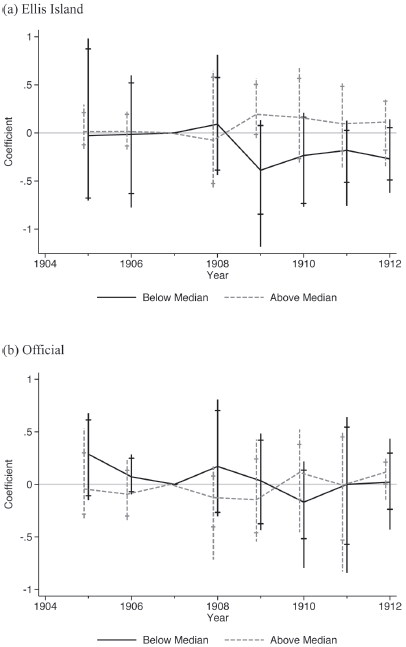
Figure 5 EVENT STUDIES DIVIDED BY SHARE OF DISTRICT EMPLOYMENT IN AGRICULTURAL DAY LABOR
Notes: Sample includes all municipalities in the regions of Sicily and Calabria. These are the coefficients β t from estimating Equation (4) with the interaction variable x i indicating that a municipality was in a district with an either above- or below-median share of employment in agricultural day labor. The coefficient for the “below median” group is arrived at by estimating Equation (4) with x i as an indicator for being in a district with above-median employment in agricultural day labor. The plotted coefficients are thus the event study for the below-median group. The “above median” group’s coefficients are arrived at analogously. The dependent variable is the logarithm of the emigration rate. Bars indicate 90- and 95-percent confidence intervals clustered on the district level, computed by a wild bootstrap.
Source: See text.
Was this heterogeneity linked to the composition of the agricultural labor force, or merely to its size relative to that of other sectors? In Column (3) of Table 5, we estimate Equation (3) with the standardized share of a district’s male labor force employed in agriculture in 1901 as x i. The coefficient is positive, but it is also smaller, and its statistical significance weaker than the interaction in Column (2). Column (4) allows for heterogeneous earthquake responses by both characteristics, effectively “horse-racing” the two. The coefficient on the interaction with general agricultural labor is reduced to zero, while the coefficient on the interaction with the share of agricultural day labor is only slightly reduced and remains statistically significant. Again, performing the same exercise with the official statistics (Columns 7 and 8) gives less conclusive results, with estimates that point in the same direction, but are weaker and statistically insignificant in the horse-race specification.
Overall, the evidence suggests that the lack of an average effect of the earthquake masks a heterogeneous response in which the least attached peasants responded positively to severe damage, whereas the more attached refrained.
Liquidity, Greater Exigencies, and Labor Demand Shocks
Another potential explanation for the lack of a discernible aggregate positive impact of the earthquake on migration is that the devastation from the disaster led to a tightening of liquidity constraints that offset any strengthening of push factors arising from the earthquake. Such a mechanism is not easily reconcilable with our previous finding that a greater share of agricultural day laborers, who were likely most sensitive to tightening liquidity constraints, was associated with a greater response to this shock. However, it is possible to test such a mechanism directly using our data on financial institutions, mutual aid societies, pre-existing migrant networks, and employment in credit. We do this by estimating versions of Equation (3) in which the normalized interaction characteristic x i is one of these measures, presenting our results for the interaction coefficient π in Table 6. In general, these results do not support the notion that liquidity constraints were important in determining migration responses. Measures of financial development in rows a–g of this table are, as a rule, not statistically significantly associated with earthquake responses, and the estimated coefficients are nearly all negative—the opposite of what we would expect from a liquidity constraints mechanism.
Table 6 HETEROGENEOUS RESPONSES WITH RESPECT TO LIQUIDITY
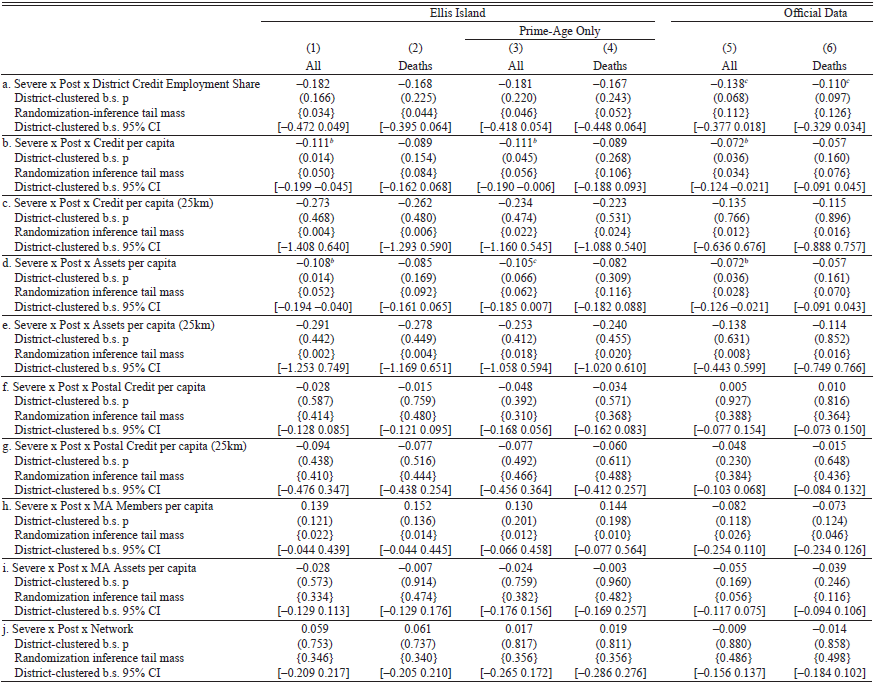
Significance levels, district-clustered b.s.: ap<0.01, bp<0.05, cp<0.1
Notes: This table presents the coefficient π on the interaction listed in each row from estimating Equation (3) with the listed dimension of heterogeneity as x i, standardized to have mean zero and standard deviation one. The dependent variable is the logarithm of emigration rates. Sample includes all municipalities in Sicily and Calabria. P-values from a wild bootstrap clustered at the district level in parentheses. Tail mass values from the randomization inference test are in curly braces. Ninety-five percent confidence intervals from the wild bootstrap clustered at the district level are in square braces. All regressions include municipality fixed effects, province-year indicators, and distance from the nearest emigration epicenter-times-post. Observations limited to 1905–1912.
Source: See text.
We also focus on two measures of social capital that would provide access to more informal support for migration—the prevalence of mutual aid societies and the size of the local migration network,Footnote 32 which is both a migration-specific measure of local social capital and a potential source of liquidity in the form of remittances and paid tickets. If increasingly binding liquidity constraints were responsible for limiting a migration response, we would expect a more positive reaction to the earthquake where social capital was thicker and thus more likely to be a substitute for self-financed migration. Some of the results in rows h–j of Table 6 are not inconsistent with this view, but overall they are weak and mixed. The coefficients on the interaction with membership in mutual benefit associations (row h) are positive when using the Ellis Island data, large in comparison to the results of Table 4, and statistically significant according to the randomization inference. However, they are negative and significant when using the official emigration statistics, and the coefficient on the alternative measure—associations’ per-capita assets (row i)—is negative and insignificant in all specifications. The interaction coefficients for the size of the migrant network (row j) hover around zero and are statistically insignificant. We conclude that there is no consistent evidence that a lack of access to credit or low social capital led to a weaker response to earthquake damage, and therefore that liquidity constraints are unlikely to have been the cause for the non-positive average effect of the earthquake.
Another potential explanation is that a rise in reconstruction labor demand provided an increasingly lucrative alternative to overseas migration. This explanation is inconsistent with the absence of a large population inflow from the hinterland to the heavily damaged cities (Table 1) and with the lengthy delays in reconstruction after the earthquake. It is also inconsistent with our findings of more positive responsiveness of areas with more agricultural day laborers, who were likely the first candidates to switch to unskilled construction jobs. Although we lack detailed data on internal migration and wages, we can look for a heterogeneous earthquake response according to the share of employment in construction in 1901. A lesser migration response from areas with a greater construction share would be consistent with a reconstruction mechanism. We estimate Equation (3) with a district’s standardized share of construction labor as the interaction characteristic x i, presenting our results in Columns (1) and (2) of Table 7.Footnote 33 In Column (1), the interaction coefficient is negative, consistent with the hypothesized mechanism, but the coefficient is small and approaches statistical significance only when using the official emigration data (Panel B). Moreover, this estimate could simply be the product of a negative correlation between employment in construction and in agriculture. In Column (2), we “horse race” the two interaction terms, finding that our agricultural day labor result is qualitatively robust, whereas the construction labor interaction becomes zero or slightly positive and statistically insignificant, inconsistent with the suspected mechanism of construction labor absorbing potential migrants.
Table 7 ADDITIONAL DIFFERENCE-IN-DIFFERENCES RESULTS WITH SHARE OF DISTRICT EMPLOYMENT IN CONSTRUCTION, DISTRICT PROPERTY OWNERS PER CAPITA, AND SHARE OF DISTRICT EMPLOYMENT IN AGRICULTURAL DAY LABOR
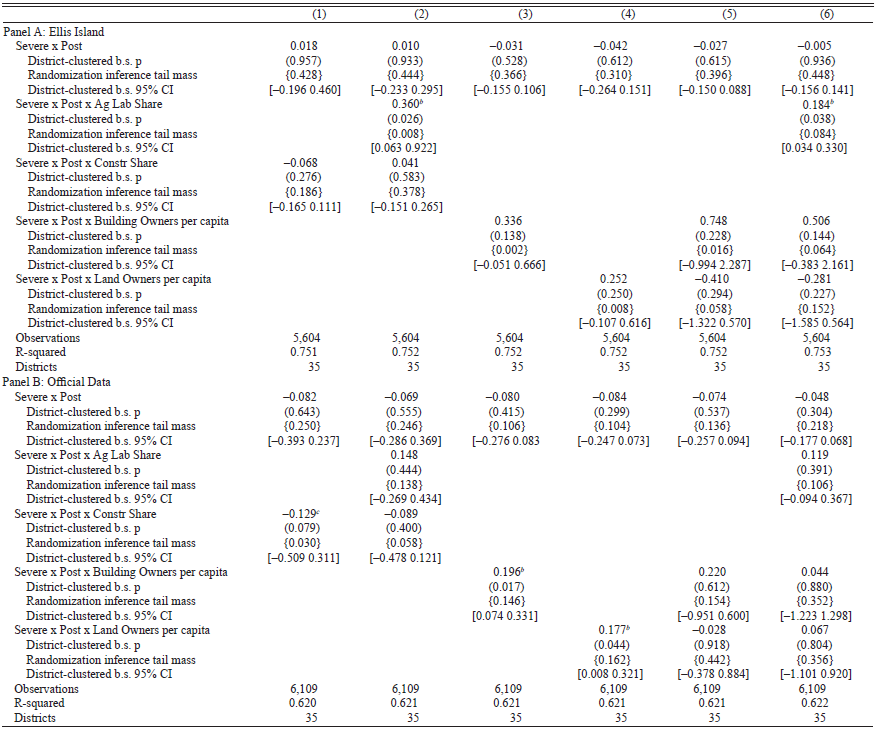
Significance levels, district-clustered b.s.: ap<0.01, bp<0.05, cp<0.1
Notes: This table presents results for β and π from estimation of Equation (3). The dependent variable is the logarithm of emigration rates from the source listed in the panel header without adjustment for deaths. Sample includes all municipalities in the regions of Sicily and Calabria. The construction labor share, agricultural labor share, building owners share, and land owners share are all at the district level and are standardized to have mean zero and standard deviation one. P-values from a wild bootstrap clustered at the district level in parentheses. Tail mass values from the randomization inference test are in curly braces. Ninety-five percent confidence intervals from the wild bootstrap clustered at the district level are in square braces. All regressions include municipality fixed effects, province-year indicators, and distance from the nearest emigration epicenter-times-post. Observations limited to 1905–1912.
Source: See text.
Bettin and Zazzaro (Reference Bettin and Zazzaro2018), David (Reference David2011), Mohapatra, Joseph, and Ratha (Reference Mohapatra, Joseph and Ratha2009), Paul (Reference Paul2005), and Yang (2008a) attribute a non-positive migration response to remittances and other financial inflows in the affected area. We were unable to locate municipality-level data on remittances that would enable us to test this mechanism, though our results for heterogeneity by the size of the migrant network do point against it.Footnote 34 Moreover, it appears that governmental financial aid to the affected area, though initially present, was limited (Di Paola and Savasta 2005). Instead, the primary channel through which government aid flowed into the area was reconstruction spending (Farinella and Saitta Reference Farinella and Saitta2019), which, as argued earlier, was unlikely to shape migration responses.
Finally, were unattached workers more positively reactive because they were not fettered by contractual obligations, or because they were not affected by the greater exigencies faced by workers who had a stake in the capital with which they were working? To tackle this question, Columns (3)–(6) of Table 7 estimate Equation (3) and its analogs, interacting the severe damage indicator with the share of building owners, the share of land owners, both shares together, and both shares alongside the share of agricultural day laborers.Footnote 35 The greater exigencies theory suggests that owners of buildings, which were the main form of capital damaged by the earthquake, would be incentivized to dedicate their own labor to rebuilding or repairing them; thus, a greater share of building owners would be associated with a lesser migration response to the shock. Land, on the other hand, was less likely to be damaged and in need of repair. Therefore, although both variables measure the prevalence of household wealth, the greater exigencies explanation predicts that the interaction coefficient with ownership of buildings would be more negative than that of ownership of land. In fact, the results of Table 7 show the opposite. When included as the sole interaction characteristic, ownership of either type has a strongly positive and often statistically significant coefficient (Columns 3 and 4). However, when both measures are included together in Column (5), the coefficient on building ownership is made more positive and approaches statistical significance more closely, whereas that of land ownership is negative. Even when the share of agricultural day laborers is added as an additional interaction variable in Column (6), the interaction coefficients of buildings remain highly positive in the Ellis Island specifications and zero in the official statistics, while that for land ownership remains negative in the Ellis Island specifications.Footnote 36
In sum, assessing to the best of our ability the common explanations for limited migration responses to disasters, the most consistent finding that helps to explain variation in this reaction is that attachment to the land hindered a short-term reaction. This does not appear to be attributable to greater exigencies for the owners of residential capital. Instead, our evidence is consistent with contracts, tenancy relations, and landownership limiting a quick emigration response to the shock.
Summary of Robustness Checks
Online Appendix D tests the sensitivity of results to dropping the cities of Messina and Reggio Calabria from our analysis to exclude their unique conditions and large death tolls, tests the sensitivity to sequentially dropping municipalities in order of the share of deaths to further ensure that potentially inaccurate death counts or the unique experiences of municipalities with high earthquake mortality do not drive our results, and tests the sensitivity of the results to re-assigning internal migrants in the main cities to other municipalities to address potential internal migration. Online Appendix I tests robustness to including the interaction of time with various controls. Online Appendix J addresses potential spillovers of treatment from severely damaged to other municipalities, in part by changing the unit of analysis from the municipality to the district.Footnote 37 In all cases, our main results are robust to these checks. Online Appendix Table B.10 assesses the robustness of our findings regarding heterogeneous responses to the earthquake shock by “horse racing” the interaction of severe-times-post with the agricultural labor share against analogous interactions with a battery of characteristics studied previously, such as various measures of liquidity. Online Appendix Table B.11 tests for heterogeneous responses to the earthquake on a variety of additional municipality characteristics not discussed earlier and “horse races” them with the agricultural labor share. In all cases, the interaction of the agricultural labor share remains largely unchanged.Footnote 38
CONCLUSION
How was emigration affected by the most devastating earthquake to strike modern Europe, which occurred in the midst of the Age of Mass Migration in one of the areas most affected by this movement? Our answer is that, on average, there was no large positive response of migration, and indeed, that there is no clear evidence of any aggregate effect, though our point estimates do indicate a short-lived and mild negative average effect. This, however, does not mean that the earthquake had no effect at all on emigration. Instead, we interpret our findings as evidence that attachment to the land acted as a barrier to responding to shocks through migration. Explanations cited for non-positive migration responses in other contexts, such as tightening liquidity constraints or labor demand generated by reconstruction efforts, are not supported by the data.
These findings contribute to a large literature seeking to understand the effects of natural disasters on migration—a contribution enhanced by the absence of restrictive migration policy in the period that we study. This literature has grown in importance in recent years: as a changing climate has increased the likelihood of natural disasters (Intergovernmental Panel on Climate Change 2012), particularly in the developing world, concern has grown over the degree to which individuals will be displaced in the aftermath of such events (World Bank 2018). It remains an open question whether and under what circumstances individuals in the affected region can find relief through migration, and specifically, whether such shocks will lead to an influx of refugees into developed countries. The case that we study demonstrates that even when borders are open and the disaster is extreme, the reaction can be a complex outcome of both positive and negative effects that aggregate to a seemingly unremarkable total.
Our analysis also provides insight into poorly understood features of the history of the Messina-Reggio Calabria earthquake—a momentous event in Italian history and in the history of the area around the Strait of Messina. These insights are particularly important given the salience of the earthquake in the history of the city of Messina and of the broader Italian nation. We depart from previous studies of the earthquake by studying international migration in response and by focusing on the experience of the population outside the two major cities. Finally, an important byproduct of our study is the revision of the magnitude of the loss of life in the city of Messina, which sheds new light on the earthquake’s tragic history.
Appendix: Demographic Accounting for Messina and Reggio Calabria
We use data on births, deaths, and emigration from the municipalities of Messina and Reggio Calabria to compute a plausible upper bound for the possible internal migration to those municipalities following the earthquake. This analysis also provides new estimates of death tolls from the earthquake for these two municipalities.
The 1911 local-born population of a municipality can be written as
where ![]() is the local-born population in year t;
is the local-born population in year t; ![]() is the death toll of local-born individuals from the earthquake; and for the period 1901–1911 b ℓ represents total births,
is the death toll of local-born individuals from the earthquake; and for the period 1901–1911 b ℓ represents total births, ![]() represents total non-earthquake deaths of local-born individuals, e ℓ is the total international emigration of local-born individuals, r ℓ is the total return international migration of local-born individuals, and i ℓ represents net in-migration of Messina-born individuals from domestic sources. The local-born population for each t is known from the census. Total births are known from the Movimento dello Stato Civile for years 1901–1911, which also provides information on total non-earthquake deaths, which we assign to the local-born and non-local-born groups according to their shares of the 1901 population. Emigration data come from the Statistica della Emigrazione Italiana per l’Estero and are assigned to local-born and non-local-born groups in the same manner as deaths. Data on return migration are available from the Annuario Statistico della Emigrazione Italiana dal 1876 al 1925, but are only at the province level and only for the period 1905–1911; we estimate the number of return migrants by using the province-level ratio of return migrants to emigrants over this period.
represents total non-earthquake deaths of local-born individuals, e ℓ is the total international emigration of local-born individuals, r ℓ is the total return international migration of local-born individuals, and i ℓ represents net in-migration of Messina-born individuals from domestic sources. The local-born population for each t is known from the census. Total births are known from the Movimento dello Stato Civile for years 1901–1911, which also provides information on total non-earthquake deaths, which we assign to the local-born and non-local-born groups according to their shares of the 1901 population. Emigration data come from the Statistica della Emigrazione Italiana per l’Estero and are assigned to local-born and non-local-born groups in the same manner as deaths. Data on return migration are available from the Annuario Statistico della Emigrazione Italiana dal 1876 al 1925, but are only at the province level and only for the period 1905–1911; we estimate the number of return migrants by using the province-level ratio of return migrants to emigrants over this period.
Table A.1 presents these figures. The missing pieces in Equation (A.1) are i ℓ and ![]() . We impose the assumption that i ℓ = 0; that is, that there was no net in-migration or out-migration of local-born individuals. In reality, we expect that this figure was negative, reflecting a net movement of individuals out of their birth municipalities. Indeed, this must be the case unless there were a substantial flow of, for instance, Messina-born individuals living outside Messina back to their hometown after the earthquake. This upper bound on i ℓ implies an upper bound on earthquake deaths
. We impose the assumption that i ℓ = 0; that is, that there was no net in-migration or out-migration of local-born individuals. In reality, we expect that this figure was negative, reflecting a net movement of individuals out of their birth municipalities. Indeed, this must be the case unless there were a substantial flow of, for instance, Messina-born individuals living outside Messina back to their hometown after the earthquake. This upper bound on i ℓ implies an upper bound on earthquake deaths ![]() , which we estimate as 29,845 for Messina-born individuals living in Messina and 7,782 for Reggio Calabria-born individuals living in Reggio Calabria.
, which we estimate as 29,845 for Messina-born individuals living in Messina and 7,782 for Reggio Calabria-born individuals living in Reggio Calabria.
TABLE A.1 DEMOGRAPHIC ACCOUNTING FOR MESSINA AND REGGIO CALABRIA, 1901–1911, LOCALLY BORN
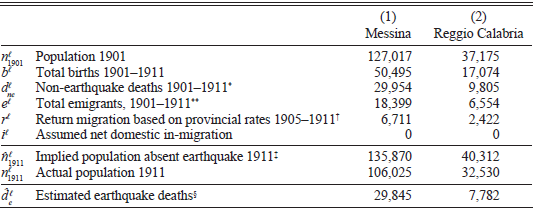
Sources: Total population by birthplace data are from Table 1. Birth and death figures are from the Movimento dello Stato Civile for 1901–1911. Emigration data are from the Statistica della Emigrazione Italiana per l’Estero for municipalities and from the Annuario Statistico della Emigrazione Italiana dal 1876 al 1925 for provinces. The latter also provides return migration data, which are available only beginning in 1905.
The non-local-born population of a municipality can be written in a manner similar to Equation (A.1), but omitting births, as
where all terms are defined and computed analogously to those in Equation (A.1). Our goal in Equation (A.2) is to determine an upper bound for i f, the net inflow of individuals born in other municipalities. We use the estimated death toll from Table A.1 and the assumption that deaths were randomly distributed between local-born and non-local born individuals according to their 1901 population shares to produce estimates of the earthquake death toll for the non-locally born of 5,348 in Messina and 1,516 in Reggio Calabria. These figures yield estimates of total deaths from the earthquake—35,193 in Messina, well short of the official count, and 9,298 in Reggio Calabria, above the official count. As these are upper bounds, they show that the official Messina death count, as suspected, is overstated, while that for Reggio Calabria is plausible.
We compute our upper-bound estimates of ![]() in Table A.2, arriving at 10,581 for Messina and 7,623 for Reggio Calabria. These are estimates of the total rate of in-migration in the period 1901–1911. Nonetheless, they are small relative to the 1901 province populations, corresponding to average annual rates of about 2 per thousand (relative to average international emigration rates of over 25 per thousand).
in Table A.2, arriving at 10,581 for Messina and 7,623 for Reggio Calabria. These are estimates of the total rate of in-migration in the period 1901–1911. Nonetheless, they are small relative to the 1901 province populations, corresponding to average annual rates of about 2 per thousand (relative to average international emigration rates of over 25 per thousand).
Table A.2 DEMOGRAPHIC ACCOUNTING FOR MESSINA AND REGGIO CALABRIA, 1901–1911, NON-LOCALLY BORN
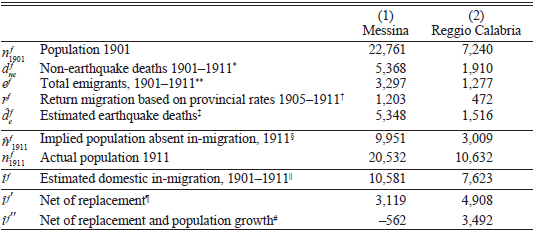
Source: See Table A.1.
Not all of these in-migrants would have come in response to the earthquake. There was likely some population movement that would have occurred in the absence of the shock. Table A.2 also includes rough estimates of how many of these internal migrants were excess internal migrants driven by the earthquake. One reasonable approximation of the population inflow that would have occurred in the absence of the earthquake is that in-migration would have occurred to replace (non-earthquake) deaths and net international emigration of non-locally born individuals. The estimate ![]() in Table A.2 provides an estimate of in-migration after removing such replacements, yielding a total in-migration of only 3,119 for Messina and 4,908 for Reggio Calabria.
in Table A.2 provides an estimate of in-migration after removing such replacements, yielding a total in-migration of only 3,119 for Messina and 4,908 for Reggio Calabria.
Another reasonable assumption is that, in the absence of the earthquake, the share of non-locally born individuals in total population would have remained constant. Under this assumption, we produce the estimate ![]() in Table A.2, which indicates a negative inflow of individuals from outside Messina into it—a net out-migration of 562 individuals—and an inflow to Reggio Calabria of only 3,492 individuals.
in Table A.2, which indicates a negative inflow of individuals from outside Messina into it—a net out-migration of 562 individuals—and an inflow to Reggio Calabria of only 3,492 individuals.

